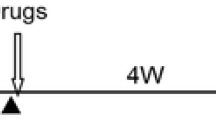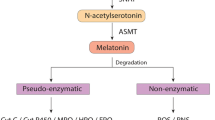Abstract
Objective
To explore the effects of Kaixin Powder (开心散, KXP) on melatonin receptor (MR) expression and 125I-Mel binding affinity in a depression rat model.
Methods
Seventy-two male Wistar rats were divided into six groups: a blank control group, model group, ramelteon group, KXP high-dosage group (HKXP), medium-dosage group (MKXP) and low-dosage group (LKXP). To establish the depression model, all groups except the blank control group were singly housed and exposed to chronic unpredictable mild stress. Weight gain, sucrose consumption and the open-field test were used to evaluate induction of depression. KXP at 260, 130 and 65 mg/(kg•d) was also respectively administered to the rats in the HKXP, MKXP and LKXP groups for 21 days. Ramelteon [0.83 mg/(kg•d)] was given to the positive drug control group. An equivalent volume of physiological saline was given to the blank and model groups. The liquid chip method was used to measure the concentration of plasma melatonin (MT). Mel1a (MT1) and Mel1b (MT2) expression levels were determined by Western blotting. In addition, a radioactive ligand-binding assay was used to analyze the specific binding properties and dynamic characteristics between MR and 125I-Mel.
Results
The results of weight gain, sucrose consumption and the open-field test showed that our model successfully produced depressive symptoms and depressive-like behavior. The concentration of plasma MT in the model group decreased significantly at night but increased in the MKXP group (P<0.05). The HKXP group showed significantly increased expression of MT1 (P<0.05); however, the expression of MT2 in all groups exhibited no significant differences (P>0.05). The maximum binding capacity (Bmax) for specific binding between MR and 125I-Mel in the MKXP group was significantly higher than that in the model group (P<0.05), but no significant differences were found in the equilibrium dissociation constant (Kd) of each group (P>0.05).
Conclusions
KXP may have a similar effect as ramelteon. KXP improved depressive-like behavior by increasing the concentration of plasma MT and MT1 expression, thereby increasing three Bmax of MR to achieve the desired antidepressant effect.
Similar content being viewed by others
References
Perahia DG, Maina G, Thase ME, Spann ME, Wang F, Walker DJ, et al. Duloxetine in the prevention of depressive recurrences: a randomized, double-blind, placebocontrolled trial. J Clin Psychiatry 2009;70:706᾿16.
Murray CJL, Lopez AD. The global burden of disease: a comprehensive assessment of mortality and disability from diseases, injuries, and risk factors in 1990 and projected to 2020. Boston: Harvard School of Public Health; 1996: 412᾿17, 445᾿48, 553᾿56, 808᾿11.
Rahman SA, Marcu S, Kayumov L, Shapiro CM. Altered sleep architecture and higher incidence of subsyndromal depression in low endogenous melatonin secretor. Eur Arch Psychiatry Clin Neurosci 2010;260:327᾿35.
Li DY, Smith DG, Hardeland R, Yang MY, Xu HL, Zhang L, et al. Melatonin receptor genes in vertebrates. Int J Mol Sci 2013;14:11208᾿1223.
Ekmekcioglu C. Melatonin receprors in humans: biological role and clinical relevance. Biomed Pharmacother 2006;60:97᾿08.
Wetterbuerg L, Beck-Friis J, Aperia B, Petterson U. Melatonin/ cortisol ratio in depression. Lancet 1979;2:8156᾿157.
Lopresti AL, Hood SD, Drummond PD. A review of lifestyle factors that contribute to important pathways associated with major depression: diet, sleep and exercise. J Affect Disord 2013;148:12᾿7.
Jang SW, Liu X, Pradoldej S, Tosini G, Chang Q, Iuvone PM, et al. N-acetylserotonin activates TrkB receptor in a circadian rhythm. Proc Natl Acad Sci U S A 2010;107:3876᾿881.
Campos Costa I, Nogueira Carvalho H, Fernandes L. Aging, circadian rhythms and depressive disorders: a review. Am J Neurodegener Dis 2013;2:228᾿46.
Srinivasan V, Zakaria R, Othman Z, Lauterbach EC, Acuña-Castroviejo D. Agomelatine in depressive disorders: its novel mechanisms of action. J Neuropsychiatry Clin Neurosci 2012;24:290᾿08.
Bersani FS, Iannitelli A, Pacitti F, Bersani G. Sleep and biorythm disturbances in schizophrenia, mood and anxiety disorders: a review. Rev Psichiatr 2012;47:365᾿75.
Bogen S, Legenbauer T, Bogen T, Gest S, Jensch T, Schneider S, et al. Morning light therapy for juvenile depression and severe mood dysregulation: study protocol for a randomized controlled trial. Trials 2013;14:178᾿88
Lader M. Limitations of current medical treatments for depression: disturbed circadian rhythms as a possible therapeutic target. Eur Neuropsychopharmacol 2007;17:743᾿55.
Haridas S, Kumar M, Manda K. Melatonin ameliorates chronic mild stress induced behavioral dysfunctions in mice. Physiol Behav 2013;119:201᾿07.
Monti JM, BaHammam AS, Pandi-Perumal SR, Bromundt V, Spence DW, et al. Sleep and circadian rhythm dysregulation in schizophrenia. Prog Neuropsychopharmacol Biol Psychiatry 2013;43:209᾿16.
Liu M, Yan JJ, Zhou XJ, Hu Y, Liu P. Effect of Kaixin San on learning and memory in chronic stress depression model rats. China J Chin Mater Med (Chin) 2012;37:2439᾿443.
Liu MY, Dong XJ, Zhang GQ, Xin HL, Liu P. Effect of Kaixin San on depression behavior and hippocampal brain-derived neurotrophic factor in mice. Acad J Second Milit Med Univ (Chin) 2012;33:1319᾿323.
Can C, Qian GQ, Zhao GP, Peng X, Liang XB. Study on regulatory effect of Kaixin San on endogenous melatonin biosynthesis in rat depression model. China J Chin Mater Med (Chin) 2012;37:1638᾿641.
GrØnli J, Murison R, Fiske E, Bjorvatn B, SØrensen E. Effects of chronic mild stress on sexual behavior, locomotor activity and consumption of sucrose and saccharine solutions. Physiol Behav 2005;84:571᾿77.
García-Cáceres C, Diz-Chaves Y, Lagunas N, Calmarza- Font I, Azcoitia I, Garcia-Segura LM, et al. The weight gain response to stress during adulthood is conditioned by both sex and prenatal stress exposure. Psychoneuroendocrinology 2010;35:403᾿13.
He SP, Hu YE, Xia ZQ, eds. Techniques in receptor research. Beijing: Peking University Medical Publishing House;2004:81᾿5,86᾿0,58᾿0.
Kobayashi Y, Itoh MT, Kondo H, Okuma Y, Sato S, Kanishi Y, et al. Melatonin binding sites in estrogen receptorpositive cells derived from human endometrial cancer. J Pineal Res 2003;35:71᾿4.
Ferguson SA, Rajaratnam SM, Dawson D. Melatonin agonists and insomnia. Expert Rev Neurother 2010;10:305᾿18.
Huan YF, Tang LN. Clinical research on the new hypnotic ramelteon. World Clin Drugs (Chin) 2006;27:556᾿59.
Miyamoto M. A novel therapeutic drug: ramelteon. Nihon Rinsho 2009;67:1595᾿600.
Willner P. Validity, reliability and utility of the chronic mild stress model of depression: a 10-year review and evaluation. Psychopharmacology 1997;134:319᾿29.
Bay E, Donders J. Risk factors for depressive symptoms after mild-to-moderate traumatic brain injury. Brain Inj 2008;22:233᾿41.
Danielczyk K, Dziȩgiel P. MT1 melatonin receptors and their role in the oncostatic action of melatonin. Postepy Hig Med Dosw 2009;63:425᾿34.
Prashant K, Kumar H, Prasad CV. In-silico study of arylalkylamine-nacetyltransferase enzyme to regulate circadian rhythmicity. Bioinformation 2013;9:771᾿76.
Webb IC, Coolen LM, Lehman MN. NMDA and PACAP receptor signaling interact to mediate retinal-induced SCN cellular rhythmicity in the absence of light. PLoS One 2013;8(10):1᾿1
De Berardis D, Marini S, Fornaro M, Srinivasan V, Iasevoli F, Tomasetti C, et al. The melatonergic system in mood and anxiety disorders and the role of agomelatine: implications for clinical practice. Int J Mol Sci 2013;14:12458᾿2483.
Weaver DR, Capedice CE. Postmortem stability of melatonin receptor binding and clock-relevant mRNAs in mouse suprachiasmatic nucleus. J Biol Rhythms 2001;16:216᾿23.
Arendt J, van Someren EJ, Appleton R, Skene DJ, Akerstedt T. Clinical update: melatonin and sleep disorders. Clin Med 2008;8:381᾿83.
Zhang HX, Huang RQ, Xiao BK, Yang JY, Zhang ZH. Research of of melatonin in depression. Sci Tech Eng (Chin) 2010;10:160᾿65.
Liang XB, Wu J, Zhao GP, Can C, Guo J. Study on the effective antidepressive component in Kaixin San by HPLC and GC-MS. Liaoning J Tradit Chin Med (Chin) 2012;39:1124᾿126.
Author information
Authors and Affiliations
Corresponding author
Additional information
Supported by the National Natural Science Foundation of China (No. 81072744)
Rights and permissions
About this article
Cite this article
Huang, Yl., Liang, Xb., Qian, Lq. et al. Effects of Kaixin Powder (开心散) on melatonin receptor expression and 125I-Mel binding affinity in a rat model of depression. Chin. J. Integr. Med. 21, 507–515 (2015). https://doi.org/10.1007/s11655-014-1787-x
Received:
Published:
Issue Date:
DOI: https://doi.org/10.1007/s11655-014-1787-x




